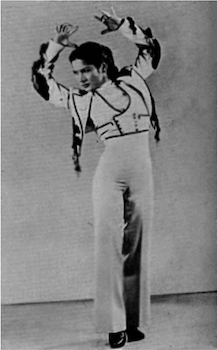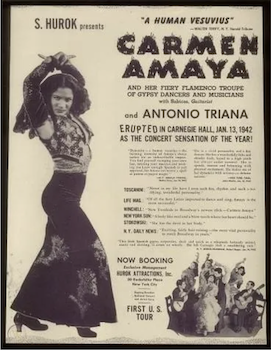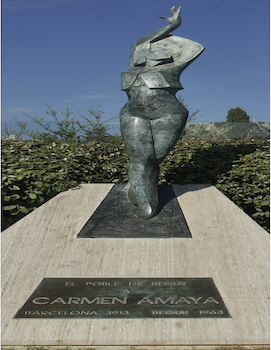
Carmen Amaya Amaya was born on November 2, 1918 in a shack in Somosrroto, Barcelona. She was born into a poor family of flamenco performers: her grandfather Juan Amaya Jiménez, her aunt La Faraona, and her mother Micaela Amaya were dancers; and her father, José Amaya, was a guitarist. She was the second out of the 11 children to be born. Out of the 11 children, only six lived.
Amaya’s career began at four years old, when she started to join her father's performances. She danced and sang as her father played the guitar in taverns and bars. This was the start of Amaya’s passion for dance and singing. Many people began talking and spread the word about her performances. Amaya started to gain popularity and even had some fans in small tablaos and theaters. Furthermore, her performances caught the eye of José Sampere, an impresario; someone who is responsible for hosting concerts, plays or anything events related to entertainment. José booked her in prestigious theaters to perform. To secure the gig, Amaya had to lie about her official date of birth in order to work legally in those theaters, such as the Spanish Theatre of Barcelona and the Paris’ Palace Theatre. In 1929, when she was 11 years old, Amaya’s name appeared in the print for the first time. Sebastián Gasch, a critic, writer, and journalist, spoke highly of Amaya’s craft in the weekly newspaper Mirador: “Imagine a 14 years old...sitting in a chair on the tablao, Carmencita remained impassive, statuary, noble with a racial elegance, inscrutable, absent, not paying attention of what is happening around her, alone with her inspiration, with a very hieratic attitude to allow her soul to raise until inaccessible areas.” Accordingly, she slowly started to gain popularity for her fierce persona, hence naming her “La Capitina” (The Caption). However, due to her focus on dance, Amaya could not receive a formal education. Despite this, she became the economic driver for her family.
In 1929, Amaya started touring Spain and Portugal with some of the most respected flamenco dancers, such as Vicente Escurado. Escurado was amazed by her dance style, and knew she was going to be revolutionary. Specifically, Amaya combined traditionally feminine and masculine flamenco dance together; the stomping, quick and intense footwork was only reserved for male dancers. However, Amaya expressed this footwork with an elegant and graceful style. She combined this style with improv which made her a very talented dancer. Escurado wanted her to debut in the USA, but it was impossible as she was still underage, resulting in the postponement of her debut for a few years. Yet, Amaya continued to receive great national attention. Carcelle, another impresario, hired her for her show and presented her at the [Teatro] Coliseum in Madrid which was a great success. She later got recognized by the world of cinema in which she got a role in the musical play called La Hija de Juan Simón, and later in María de la O, Pastora Imperio and many more!

When the Spanish Civil war broke out on July 18, 1936, Carmen and her family were in Zorilla Theatre in Valladolid, Carcelle’s company. They were also financially doing well and they even bought their first car. Unfortunately, due to the Spanish Civil War, the car got confiscated near the time they had to go to Portugal to sign a contract; they delayed their trip to Portugal until November. They then arrived to Bueons Aires, Argentina, after a 15 day-boat trip. Her family originally planned to stay there for two weeks, but ended up staying for nine months due to Amaya’s massive success. Her shows went beyond her and her team’s expectations as tickets got sold two months in advance. Amaya’s triumph resulted in the construction of a theater named after her: the Teatro Amaya. She even toured across South America; in Mexico she danced everyday in two different venues: Teatro Fábregas and Tablao El Patio.
In 1941, when she was 23 years old, an impresario named Samual Hurok allowed Amaya to debut in North America in a Broadway where she would tour at venues in both the USA and Canada. During this tour, she met several celebrities and influential people, all of whom were very impressed by her dancing, such as Charlie Chaplin and Greta Garbo. The musician Toscanni commented that he had never seen someone move in such an enormous rhythm with an enormous tempo in her style of movement. For outfits, Amaya preferred a shirt, short jacket and pants over a dress. She often wore traditionally masculine clothing as she performed quick footwork that was only reserved for men. Her outfits broke down the toxic masculinity associated with flamenco dance. Although she was not the first woman to do this, she was the most remarkable woman to do so.

During her time in America she dated a Spanish flamenco guitarist Sabicas for nine years. In December 1941, she finished her North America tour at Carnegie Hall in New York. All the tickets quickly sold out. In America, she met US President Franklin D. Roosevelt, and she performed a recital in the White House. She also met high-ranking officials, such as General Macarther who named her the ‘honorary captain’ of the US Navy.
In 1947, Amaya returned to Spain as a worldwide star. She missed her hometown while abroad, so she performed in her country in many cities, embracing her roots. After staying in Spain for a while, she began a tour in Europe; her first destination was Théâtre des Champs Elysées, Paris in 1948, then London and other European countries. In London, Queen Elizabeth II and Prime Minister Winston Churchill watched Amaya perform; they were amazed by her performance and later congratulated her for it. In 1952, she married guitarist Juan Antonio Agüero but had no children.

Unfortunately, the 1960s were Amaya’s last decade of her life due to renal failure in the kidneys; her body could not eliminate the toxins piling up in her body and there was no medical solution for her situation at the time. Despite the circumstances, she continued to perform and was shooting a film Los Tarantos in 1963 before she passed away on November 19th, 1963 at the age of 45 in Bagur, Girona. Many were in grief when they heard this news. International obituaries and programmes were held for her in the press, radio, and television.
Today, Amaya is recognized as one of the most talented flamenco dancers in history. She is one of the many flamenco dancers who are celebrated on International Flamenco Day which is on November 16. Furthermore, in 1966, three years after Amaya’s death, she was honored to have a monument constructed in the Montjuïc Amusement Park. On February 15, 1959 before she passed away, the Barcelona City Council decided to name a fountain dedicated to her at the esplanade Paseo Marítimo de Barcelona inauguration.
Amaya also popularized the concept of women wearing trousers for women’s dance along with her unique dance style. Amaya’s legacy continues to be a muse for the current and future generations of dance, and her artistic contributions continue to inspire and charm people across the globe.
Why Did I Choose to Research Carmen Amaya Amaya?
One day, I saw an Instagram post displaying Carmen Amaya’s dance while explaining her dance revolution. I noticed she was dancing in heels while breaking toxic masculinity in flamenco dance. Growing up I have always been fond of dancers, and I was quickly amazed by the way Amaya quickly and gracefully moved at such speed and intensity while wearing heels, and that is when I knew I wanted to learn more about her upcoming career. I sometimes like to dance in my free time, but always shy away from high-speed and intense choreographies. However, Amaya inspires me that dancing at high intensity and speed is possible as a woman as long as I have the passion and mindset for it! Interestingly, as I was researching more about Amaya, I found it intriguing that she was able to reach this amount of success and revolutionize dance with the help of men in the business and entertainment industry, which was male-dominated; depicting the importance of teamwork and gender equality.
Works Cited
Amaya, Andalucia | Southern Spain,. (2020). Andalucia.com. https://www.andalucia.com/flamenco/dancers/carmenamaya.html
Biography of the dancer Carmen Amaya. (n.d.). Pureflamencobarcelona.com. https://pureflamencobarcelona.com/en/biography.php
Carmen Amaya - RomArchive. (n.d.). Www.romarchive.eu. https://www.romarchive.eu/en/flamenco/carmen-amaya/
Carmen Amaya’s 110th Birthday Doodle - Google Doodles. (n.d.). Doodles.google. Retrieved June 22, 2024, from https://doodles.google/doodle/carmen-amayas-110th-birthday/
Carmen Engel, K. L. (2022, November 4). Carmen Amaya, Queen of the Gypsies | Amazing Women In History. Amazingwomeninhistory.com. https://amazingwomeninhistory.com/carmen-amaya-queen-of-gypsies-flamenco-dancer/#:~:text=A%20pioneer%20in%20flamenco%2C%20Carmen
Operations. (2023, October 19). Carmen Amaya: From Misery to Hollywood. ALL FLAMENCO. https://allflamenco.net/en/carmen-amaya-biography-anniversary/
Remembering Carmen Amaya Death: Illness And Health Issue - BlogPaper. (n.d.). Jejegegerz.s3.Uk.io.cloud.ovh.net. Retrieved July 4, 2024, from https://jejegegerz.s3.uk.io.cloud.ovh.net/remembering-carmen-amaya-death-remembering-carmen-amaya-death.html
Zatania, E. (2023, November 2). The legacy of Carmen Amaya 60 years after her passing. Expoflamenco. https://www.expoflamenco.com/en/estela-flamenca/the-legacy-of-carmen-amaya-60-years-after-her-passing/
This article was published on 7/24/24